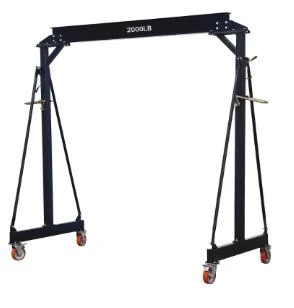Efficiency and Versatility of Steel Gantry Cranes in Modern Industrial Applications
Understanding Steel Gantry Cranes A Comprehensive Overview
Steel gantry cranes are an essential component in various industries, providing a robust and reliable solution for lifting and moving heavy loads. These cranes are characterized by their unique design, which includes a bridge that spans the width of a workspace, supported by two or more legs that run on wheels or tracks. Their versatility and strength make them an ideal choice for construction sites, warehouses, and manufacturing facilities.
Design and Structure
The design of steel gantry cranes typically features a combination of high-quality steel frames and robust components that ensure stability and safety during operation. The main elements of a gantry crane include the beam, legs, and the hoisting mechanism. The beam, often made of steel I-beams, is designed to bear heavy loads and distribute weight evenly across the structure. The legs, which can be adjustable or fixed, provide the necessary support and mobility while ensuring the crane remains anchored during lifting operations.
One of the key advantages of steel gantry cranes is their ability to be customized according to specific needs. They can be designed in various heights, spans, and load capacities, allowing them to be tailored for different environments and applications. Additionally, features such as powered wheels, adjustable heights, and integrated safety mechanisms can be included to enhance functionality and operational safety.
Versatility in Applications
Steel gantry cranes are widely used across multiple industries due to their versatility. In construction, they facilitate the lifting of heavy materials such as steel beams, concrete blocks, and machinery, streamlining workflows and improving efficiency. In warehouses, they assist in moving large pallets and boxes, providing a cost-effective solution for material handling.
Manufacturing plants also benefit from the use of gantry cranes. They enable workers to lift components and products safely and with minimal effort, reducing the risk of workplace injuries associated with manual lifting. Furthermore, in maintenance operations, gantry cranes are often employed to hoist engines or large equipment for repairs, making them indispensable tools in service and repair environments.
steel gantry crane

Advantages of Steel Gantry Cranes
The choice of steel as the primary material for gantry cranes comes with several significant benefits. Firstly, steel's high strength-to-weight ratio means that cranes can handle substantial loads while maintaining structural integrity and safety. Unlike aluminum or other materials, steel offers durability and resistance to wear, ensuring a longer lifespan and reduced replacement costs.
Another advantage is the flexibility in design and mobility. Steel gantry cranes can be easily relocated within a facility or across job sites. This feature is particularly useful for companies that frequently shift their operations or require temporary lifting solutions.
Moreover, steel gantry cranes often come with cost-effective solutions. They generally require lower initial investment compared to permanent cranes, such as overhead cranes. This cost-effectiveness, combined with their operational versatility, makes them a preferred choice for many businesses.
Safety Features and Considerations
Safety is paramount when operating steel gantry cranes. Modern designs often incorporate various safety features, including limit switches to prevent over-lifting, emergency stop buttons, and safety locks to secure loads during transit. Regular maintenance and inspections are crucial to ensure these cranes operate safely and efficiently. Operators must also be trained to understand the crane’s capabilities and limitations to prevent accidents and ensure optimal performance.
Conclusion
In summary, steel gantry cranes are an invaluable asset for industries requiring heavy lifting and material handling solutions. With their sturdy design, versatility, and cost-effectiveness, they serve a variety of functions across different sectors. As industries continue to evolve and demand greater operational efficiency, steel gantry cranes will undoubtedly remain a cornerstone of effective material handling and lifting solutions. Understanding their design, applications, and safety features is essential for businesses looking to invest in efficient lifting equipment.
-
Unlock Seamless Relocation with Our Heavy Equipment Moving ExpertiseNewsJun.06,2025
-
Unleash Unrivaled Flexibility with Our Adjustable Gantry CraneNewsJun.06,2025
-
Unleash Heavy-Duty Efficiency with Our Industrial Gantry Crane SolutionsNewsJun.06,2025
-
Revolutionize Steel Handling with Our Magnetic Lifter RangeNewsJun.06,2025
-
Master Equipment Mobility with Premium Machinery Mover SolutionsNewsJun.06,2025
-
Elevate Your Material Handling with Magnetic Lifter TechnologyNewsJun.06,2025
-
YS Permanent Lifting Magnets: The Smarter Way to Handle SteelNewsMay.22,2025
